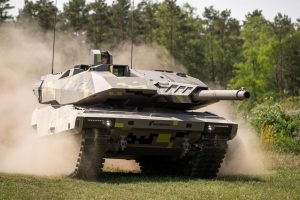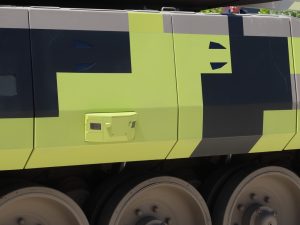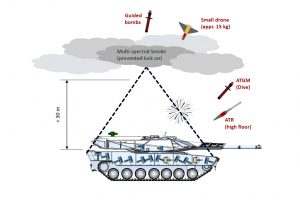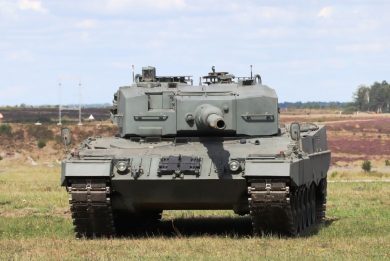
Increasing survivability while lowering the protection-induced mass
Main battle tanks are quite certainly the most protected vehicles on the battlefield, however at least until now increasing the level of protection meant augmenting the vehicle weight. A comparison between the Leopard 2A4 and the Leopard 2A7 V shows that the former is an MLC60 vehicle, it can cross Military Load Class 60 bridges, while the latter falls in the MLC80 category. Both have an armour package based on passive protection.

An interesting pie diagram provided by Rheinmetall shows the average percentage in weight of the main elements of an MBT: running rear 23%, gun and ammunition 10%, sighting system & fire control 5%, power pack and fuel tanks 13%. Hull and protection accounts for the remaining percentage of the weight, which is 49%.
Increasing the protection level while bringing back the Panther under the 50 tonnes mark was the aim of Rheinmetall engineers. To do so they adopted a hybrid protection concept, which is a mix of passive, reactive and active elements, Stefan Haase, Managing Director Rheinmetall Active Protection GmbH, explained.
For years western armies were confronted to asymmetric scenarios, the main threats being RPGs and, seldom, antitank missiles. Peer to peer scenarios bring back to MBT versus MBT confrontations, the main threat coming therefore from KE projectiles such as the Russian BM-42 APFSDS. “We have already shown that we are able to kill such a KE penetrator with our active defence system,” Stefan Haase states, underlining how much this allows reducing the amount of other types of armour, thus decreasing the overall weight of the tank protection package. EDR On-Line understood that the system is way below the 1 millisecond reaction time, the word microseconds was mentioned, in order to cope with those high velocity penetrators. This means that the active component should be an evolution of the original ADS developed by then IBD Deisenroth, a company that has since been acquired by Rheinmetall becoming the aforementioned Rheinmetall Active Protection GmbH. Sensors reaction times have also certainly been reduced in order to cope with this threat, wereas originally the ADS was mostly devoted to counter slower incoming projectiles, such as RPGs and missiles. The effector was defined at that time a “blade of energy” that was generated by tiles installed along the vehicle chassis. Rheinmetall developed that concept, and at IDEX 2019 a hybrid modular solution was exhibited, which included sensors and the effector. How much the current solution is a derivative of that one is not known; talking to company representatives we understood that now two different types of effectors are available, one to defeat ATGMs and RPGs, which require a lesser energy to be neutralised, and one generating a much higher energy, devoted to brake KE penetrators.

In fact “neutralising” was not the word used by Mr. Haase referring to KE projectiles, as he spoke of a “significant performance reduction” of the incoming round. In order to hit the penetrating rod, usually tungsten, at some distance from the tank, the energy blade is activated when the penetrator is at 10-15 meters in order to engage it at “short distance”, considering its very high speed. This is broken into pieces, probably 2 to 4, each of them hitting the MBT with still a considerable energy, although with an angle far from the optimal. Multi-hit protection is provided by tiles covering overarching sectors, sensors being capable to “understand” the type of incoming projectile, mainly due to the huge difference in speed, activating the appropriate tile. In terms of potential collateral damages, the higher energy generated by “KE tiles” should not be a major problem, as a direct confrontation between tanks seldom happens in presence of civilians, while the lower energy “ATGM tiles” should inherently reduce the risk of collaterals. According to the speaker, Rheinmetall improved the performances of its active protection system in the last few years. Its effectors will be located alongside the upper-end of the Panther chassis, protecting both the turret and chassis, which should mean they can generate energy diagonally either downwards or upwards.
Stefan Haase explained that dealing with the chemical energy threat, which in other terms means shaped charge rounds, with active systems, allows to concentrate the work on passive armour mainly to defeat the KE threat, or at least the residual KE threat left after an APFSDS round has been engaged by the active system.
Rheinmetall considers the integration of grenade-launcher types of active protection systems, such as the Trophy, “which have a high potential in defeating top attacks,” Stefan Haase said. And this links us up with an emerging threat that has shown its effectiveness on the battlefield, would it come from missiles or LMs. The launcher integration will be dealt with in the next design iteration of the Panther.

Rheinmetall refers to a possible defensive system against threats coming from the third dimension using the acronym TAPS, which means Top Attack Protection System. Not many details were provided, by the Düasseldorf based company claims it has developed the core of the system, while effectors have not yet been decided, as these can be a laser beam, a high rate of fire small calibre machine gun, or others, as discussed in the lethality part of this article. A multi-sensor, multi-effector modular layered system, the TAPS can also include a grenade-launcher type system can be integrated, as well as a multi-spectral smoke screening system, which would generate a cloud over the tank, avoiding incoming projectiles to lock on the target, Rheinmetall’s MASS system being one example. This would require sensors with longer ranges, around 500-600 meters, compared to those used in active systems, as smoke takes time to generate. Such systems would allow evolving towards automatic hemispheric deployment of the smoke cloud providing thermal and optical camouflage.
Reactive armour is also being integrated into the survivability package, exploiting the same sensors and same ignition systems used for the active countermeasures, which according to Stefan Haase provide the same level of safety. This means stepping from current impact-triggered to sensor-triggered reactive armour packages covering the crew compartment, including top attack protection.
All this leads to a lesser weight of the package compared to passive armour ones, According to Dr. Haase Rheinmetall carried out a series of tests against a number of evolutive armour packages, shooting against 30×30 cm plates, and these showed a good correlation between simulation and real tests. It allowed to verify the thickness reduction of the base armour, mostly steel-based, against overpressure effects, which is key for coping with the 50 tonnes limit of the Panther/KF51.
Photos and images courtesy Rheinmetall and P. Valpolini



